Post updated May 2015, May 2016, and April 2017 with additional pictures
I have been thinking about head covering options for female Norse re-enactors quite a bit recently, and I have also seen several questions come up in various on-line conversations. Because there is very little concrete evidence in this area, there are a lot of gaps that need to be filled with conjecture. These are my conclusions, but I would love to hear the views of other people who have studied this topic!
First of all, did Viking Age women wear a head covering? There is not enough evidence to give a conclusive answer to this question, and the answer might also vary based on social class, formality of event, weather, or other factors that we haven’t considered.
I don’t think that pagan Scandinavian women necessarily had religious pressure to cover their hair, but I feel that the evidence points toward styled hair and/or a head covering of some type. Styling the hair and wearing some type of head covering would have been practical; wearing hair up keeps it out of the way and covering it helps to keep in clean. I think that the available evidence supports the idea that loose, uncovered hair isn’t very likely in a Viking Age context.
Some pre-Viking Age archaeological finds provide support for the idea of head wear in general; bog bodies from Arden Mose and Haraldskjaer both include sprang caps. These finds indicate that head coverings did not arrive in Northern Europe with Christianity, so religious pressure is clearly not the only reason the women wore head coverings. There is also archaeological evidence of head-coverings during the Viking Age (headbands, scarves and caps from Dublin, cap from Jorvik, tablet woven headbands with evidence of a veil underneath from Birka), although the archeological record gives very little information about how these items were worn.
Most pre-Viking and Viking Age depictions of women show a knot with streamers at the back of the head. Many of the representations are difficult to interpret, but there are a few cases in which it is clear that the knot is hair (others could also be a scarf or veil wrapped around the head). This is often used as evidence that Norse women didn’t wear any type of head covering, but it is important to consider that these figurines are generally thought to represent goddesses and the knotted hairstyle might have had social or religious significance. There is no archeological evidence for the knotted hairstyle, but there is pre-Viking Age evidence for elaborate hairstyles – Arden woman’s hair was worn twisted and wound around the head (under the sprang cap) and Elling woman’s hair was arranged in an elaborate braid which was tied in a knot.
There are many discussions of women’s head coverings in various sagas and in the poem RígsÞula. In general I think this supports the idea that most women wore some type of head covering, although it is important to remember that this evidence is not conclusive since these stories were not written down until several hundred years after the Viking Age.
Taking all this evidence in to account, I feel the there are several different options for women doing Norse re-enactment, including styled hair and various head covering options. I do not see any evidence for long hair worn loose.
Some options:
1. Styled hair – several Valkyrie figurines are depicted with long hair worn in a knotted ponytail, and one Iron Age figurine seems to show a women with buns on each side of her head. There is also the possibility of hairstyles inspired by Arden woman or Elling women.
2. Knotted scarf – some Valkyrie figurines look like they could be wearing a knotted scarf around the head. There is also saga evidence of a twisted or knotted scarf (for example, in Viglundar saga a linen bandage wound around the head is compared to a woman’s head cloth). Because this style would be unlikely to leave any archaeological trace, it is difficult to tie to a particular location.
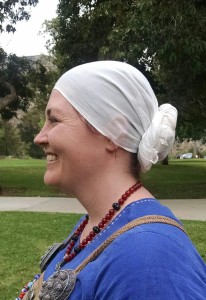
One option for a knotted headscarf. In this style the scarf is wrapped around the head, and the tails are twisted together and coiled on the back of the head. If you style you hair in a bun, you can use the bun as the center of the knot. This scarf is rectangular, 52cm by 165cm
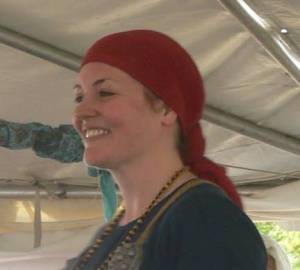
Another option for wearing a knotted scarf – in this style the ends of the scarf are gathered at the nape of the neck and tied in a knot. This style results in a very distinct knot at the nape of the neck. This scarf is rectangular, 83cm by 147cm.

A third option for wearing a knotted scarf (back view) – in this style the front corners of the scarf are tied together at the nape of the neck, and then those ends are tied again to confine the tails of the scarf.
3. Draped scarf or veil – This style is similar to the depiction of the Virgin Mary in the Book of Kells and some Anglo-Saxon women, so I suggest this option particularly for re-enactors depicting the British Isles.
3. Headband – headbands of silk and wool have been found at Dublin, and several graves from Birka have remains of metal-brocaded tablet weaving around the head. Evidence from Birka indicates that the headband could be worn horizontally around the head, along the hairline, or around the crown of the head.

Silk headband decorated with brocaded tablet weaving
4. Cap – extant examples from the British Isles only (Dublin and Jorvik), so this style is also primarily for re-enactors depicting women from the British Isles.
5. Headband and scarf – there is evidence from Birka of a scarf or veil worn under a tablet woven headband. In the extant examples the headbands are brocaded with metal threads, however it is possible that tablet woven headbands without metal brocading were also worn in this fashion. Headbands and scarfs of silk and wool fabric were found at Dublin, so it is possible that this style worn in various areas of the Viking world. Depending on how the scarf is worn, this style also has parallels with contemporary Anglo-Saxon and Rus women’s costume.

One way of wearing a headband and scarf. In this case the scarf is tied with a distinct knot at the back, and a woven headband is tied following the hairline. The headband helps hold the scarf in place. This scarf is rectangular, 54cm by 260cm.

Another way of wearing a headband and scarf. In this case the front corners of the scarf are tied or pinned at the base of the neck, and the tails hang freely. A brocaded tablet woven headband is worn along the hairline.

Another option – in this case the brocaded tablet woven headband is worn horizontally around the head.
Some resources on this topic include:
Hägg, Inga “Die Tracht.” Birka. Untersuchungen und Studien. II:2. Systematische Analysen der Gräberfunde. (Ed. G. Arwidsson). 1986, 51-72. (discussion of brocaded headbands from Birka)
Heckett, Elizabeth Wincott. Viking Age Headcoverings from Dublin. Royal Irish Academy, 2003. (caps. headbands and scarves from Dublin)
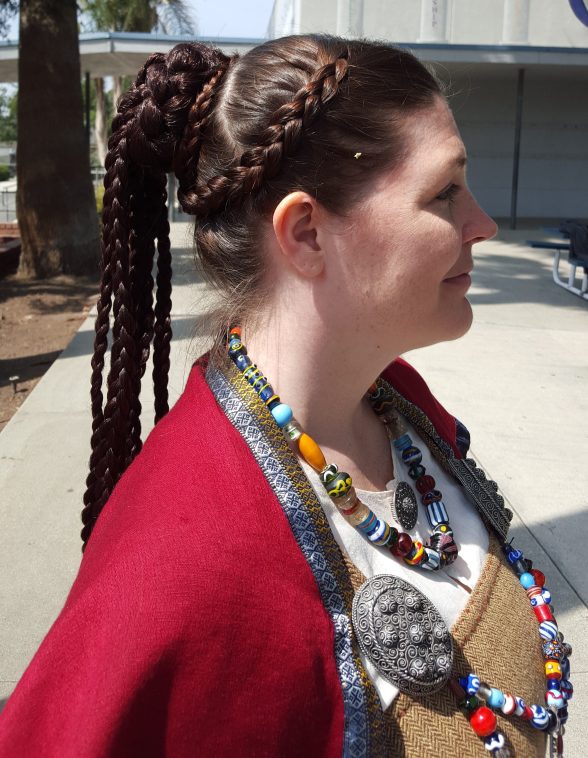




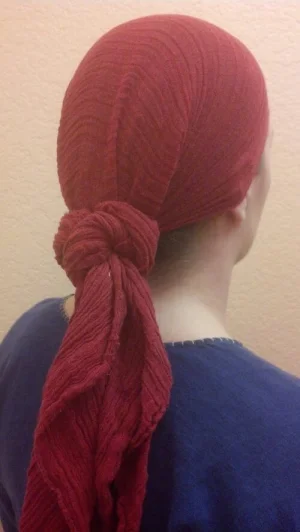


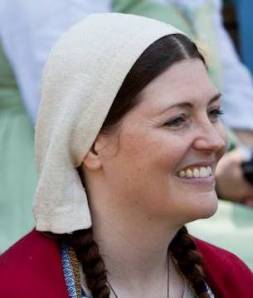


Having a Norse persona myself I relate to issues of hair covering and style. The archaeological record is spotty no matter how deep you research and art is..well art. You have done a fantastic job interpreting the current held beliefs and pointed out to me that that Tablet band could have been worn “head band” style. Thank you.
Thanks, I am glad the post was helpful for you!
I was really excited when I found this article, as I’m interested in Norse and Viking history as well.
Another article you may be interested in about a bog find, with similar hair to that of the common Valkyrie images is at: http://www.tollundman.dk/ellingkvinden.asp (If it reverts to the Danish, there’s a translate button at the top right of the page).Although the bog find is from a couple hundred years before the Vikings roamed, it’s at least a clue to how their ancestors may have dressed their hair…it’s also an incredibly comfortable hairstyle for someone with long hair, as the small braid that the hair is knotted around nicely distributes the weight of the hair over the rest of the head, reducing headaches that can happen from buns/knots that put pressure on one part of the hair. It also doesn’t require sticks or combs to stay secure, only a string (or hair tie) to keep the braid from unraveling.
Thanks Heather, that is a nice article about the Elling woman’s hair style.
I have a question about the red scarf. Is that a cotton gauze? Would a modern gauzy scarf work for that?
The red scarf is linen gauze. There is evidence that linen, silk and wool were used for head coverings. If you were going to use a modern scarf I would recommend something like a pashmina.
How big would such a scarf be? I notice that you used the same scarf both for the wrapped veil and the knotted style. Both are looks I would like to try myself.
There is very little archeological evidence of veils, but some scraps from Dublin indicate that the may have been very narrow (between 10 and 25 cm wide). The size of my veils vary somewhat, although they are all wider then the Dublin examples (the narrowest is about 40cm wide). All of my veils are at least 150cm long. I suggest that you play around a little and see what size works best for you.
Thank you for this page. I needed to make a medieval costume for a school day (I’m a teacher) and this page helped me figure out a head covering.
[…] Margaret (https://ciarsstitchintime.wordpress.com/2013/10/24/viking-age-head-coverings/) Viking Age head-coverings. October 2013, accessed November […]
Would you please say the dimensions of each scarf you are using. The pics look lovely! Thanks for posting them.
Sure, thanks for the suggestion!
Hi. I started reenacting about 6 months ago and have been looking for a head covering because I have a short (good for my rank: thrall) modern haircut with hot pink streaks (not good for any rank or era). My persona is early settlement of Iceland and was wondering if you had any information on that specific place and time.
Unfortunately I haven’t seen any sources that are that specific
Have you checked out the Viking Answer Lady’s page yet? She’s been a great resource for years and years and goes into specifics. 🙂
The Viking Answer Lady is a great resource.
I wear a covering,like the style shown using the red scarf (Anglo saxon style ) and usually use a pashminas (woollen) for warmth in winter (Ireland). Am interested in the Jorvik cap, do you know how it is made.
The Jorvik cap is quite easy to make. It is a long rectangle folded over the head, with a seam up the back the curves to shape the cap to the head. Does that make sense? Here is a picture of the inside of mine
I have now made one of these. Dead easy but don’t really keep sun off the neck so make sure you are greased in hot weather. I went a bit pink at Godmanchester last weekend
Very Educational !
Very comprehensive and interesting, thank you
Did you teach this at Gulf Wars this year?
Nope I haven’t made it out to Gulf Wars in several years
Would it be okay to copy some of your pictures for a class I want to give at GWW about what to wear on your head with Viking clothing?
Sure, please credit them to me.
[…] of how difficult it can be to come up with anything definite, here’s two articles on veils: Norse, from which I borrow some ideas, and a pretty thorough article (for English) that also draws from […]
What a wonderful resource, thank you for all the hard work you put into this.
Thank you! I am glad you found it useful.
Up too the start of the 20th century women in rural Norway hardly left their home without a headpiece. It would not only protect for rain og wind but allso show if the woman was married or not. The vikings would probably do something of the same?
It is possible, but we do not know if the head covering gave any indication of marriage. It did for some cultures, but not for all.
Thank you for this writing this resource. I have just started my SCA journey and this answered all of my queries about the “hair” issue.
I am so glad it was helpful!
I love this, thank you! I’ve referenced your page often when talking to others about viking era head covering. but I truly envy your knotted hairstyles. Any chance you could put together a tutorial on those? (Assuming your fiend Lorissa would help?)
Great article! Just as an aside, the brooches seen in some of your photos were originally likely worn lower, over the breasts, prior to the coming of Christianity to Scandinavia.
See:
https://www.livescience.com/2314-viking-women-dressed-provocatively.html
Hi Nicholas. I am familiar with the interpretation in that article, but I do not agree with her conclusions
For the upper class in British Isles a silk hairnet may be yet another possibility – there are some examples from Dublin and Waterford in Ireland.
[…] Oltre al succitato libro, consiglio di leggere anche questo articolo scovato da Pinterest, che allega molte immagini e aiuta a farsi un’idea: https://ciarsstitchintime.wordpress.com/2013/10/24/viking-age-head-coverings/amp/ […]
Thank you. Your pictures and explanations are clear and easy to follow. How large a square do you use?
The size varies, but they are around 40cm wide and at least 150cm long. I suggest that you play around a little and see what size works best for you.